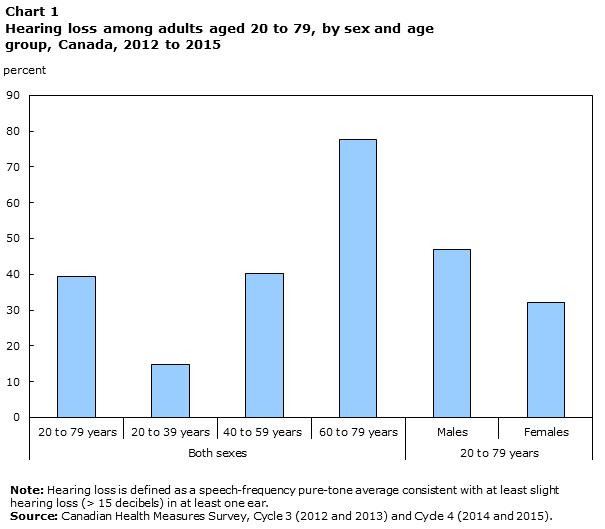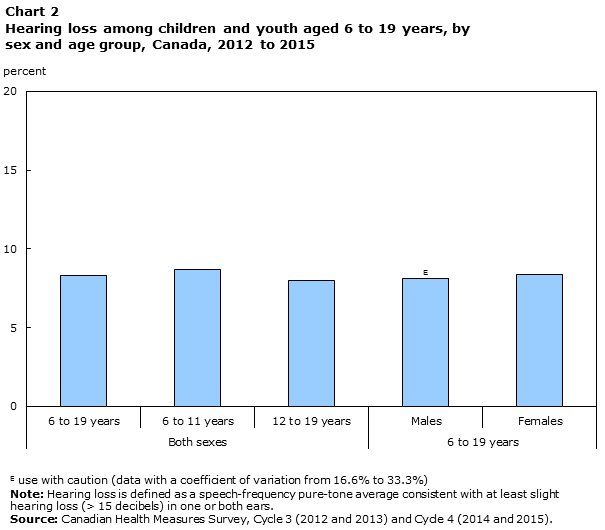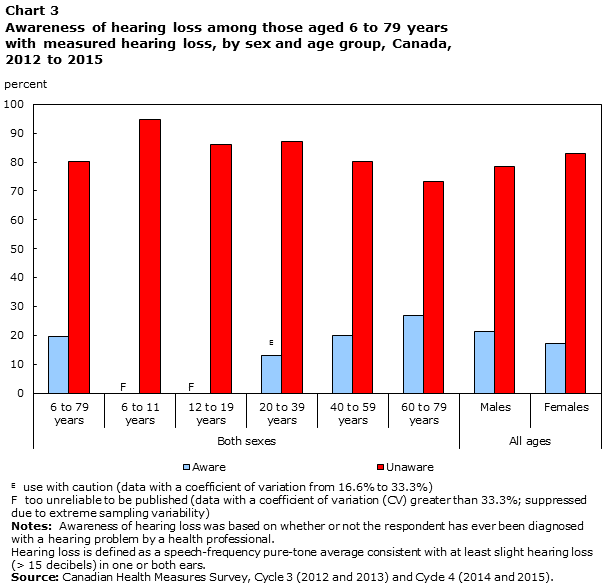Health Fact Sheets
Hearing loss of Canadians, 2012 to 2015
Archived Content
Information identified as archived is provided for reference, research or recordkeeping purposes. It is not subject to the Government of Canada Web Standards and has not been altered or updated since it was archived. Please "contact us" to request a format other than those available.
Hearing loss is an important health concern which is often unrecognized and undertreated.Note 1Note 2 Hearing loss can have many emotional and social consequences including social isolation, depression, safety issues, mobility limitations and reduced income and employment opportunities.Note 3Note 4 In older adults, hearing loss has also been shown to be associated with poor quality of life and functional limitations.Note 1Note 2 In children and youth, there is evidence that hearing loss negatively affects academic performance and language development needed for classroom learning and vocational achievement.Note 5Note 6
Hearing loss in adults
Audiometry results from the 2012 to 2015Note 7 Canadian Health Measures Survey (CHMS) indicate that 40% of adults aged 20 to 79 had at least slight hearing lossNote 8 in one or both ears (Chart 1). Hearing loss was more prevalent in older age groups. Adults aged 60 to 79 were significantly more likely to have hearing loss (78%) compared with younger adults aged 40 to 59 (40%) and 20 to 39 (15%). Males (47%) were significantly more likely to have hearing loss compared with females (32%).

Data table for Chart 1
| Hearing loss | ||
|---|---|---|
| percent | ||
| Both sexes | 20 to 79 years | 39.5 |
| 20 to 39 years | 14.7 | |
| 40 to 59 years | 40.3 | |
| 60 to 79 years | 77.6 | |
| 20 to 79 years | Males | 46.8 |
| Females | 32.2 | |
|
Note: Hearing loss is defined as a speech-frequency pure-tone average consistent with at least slight hearing loss (> 15 decibels) in at least one ear. Source: Canadian Health Measures Survey, Cycle 3 (2012 and 2013) and Cycle 4 (2014 and 2015). |
||
The survey assessed hearing loss as either unilateral (occurring in only one ear) or bilateral (occurring in both ears). Hearing loss was unilateral in 37% and bilateral in 63% of adults with at least slight hearing loss (data not shown). Bilateral hearing loss was significantly more likely in the older age groups. Nearly 1 in 3 adults aged 20 to 39 with hearing loss had bilateral loss compared with half of those aged 40 to 59 and 3 in 4 of those aged 60 to 79 (data not shown).
Hearing loss in children and youth
Audiometry results indicate that 8% of children and youth aged 6 to 19 had hearing loss that was considered slight or worse (Chart 2). Unlike adults, the prevalence of hearing loss did not differ by sex among children and youth. The majority (79%) of children and youth with hearing loss had hearing loss in only one ear (unilateral, data not shown).

Data table for Chart 2
| Hearing Loss | ||
|---|---|---|
| percent | ||
| Both sexes | 6 to 19 years | 8.3 |
| 6 to 11 years | 8.7 | |
| 12 to 19 years | 8.0 | |
| 6 to 19 years | Males | 8.1 |
| Females | 8.4 | |
|
Note: Hearing loss is defined as a speech-frequency pure-tone average consistent with at least slight hearing loss (> 15 decibels) in one or both ears. Source: Canadian Health Measures Survey, Cycle 3 (2012 and 2013) and Cycle 4 (2014 and 2015). |
||
Audiometry tests were not conducted on children aged 3 to 5. However, results from the otoacoustic emissions testing and tympanometry indicate that about 4% of children aged 3 to 5 had results consistent with conductive hearing loss (data not shown, see About hearing). Conductive hearing loss can indicate the potential for temporary or permanent hearing loss.Note 9
Awareness of hearing loss
The majority of Canadians with measured hearing loss were not aware they had any hearing problems (Chart 3). About 77% of adults with at least slight measured hearing loss did not report a diagnosis of hearing problems by a health care professional, while the same occurred in 95% of children aged 6 to 11 and 86% of youth aged 12 to 19. Males and females were similar in that 79% of males and 83% of females with at least slight measured hearing loss did not report a diagnosis of a hearing problem.

Description for Chart 3
| Aware | Unaware | ||
|---|---|---|---|
| percent | |||
| Both sexes | 6 to 79 years | 19.7 | 80.3 |
| 6 to 11 years | Note F: too unreliable to be published | 94.6 | |
| 12 to 19 years | Note F: too unreliable to be published | 86 | |
| 20 to 39 years | 13Note E: Use with caution | 87 | |
| 40 to 59 years | 19.9 | 80.1 | |
| 60 to 79 years | 26.8 | 73.2 | |
| All ages | Males | 21.4 | 78.6 |
| Females | 17.2 | 82.8 | |
|
E use with caution F too unreliable to be published Notes: Awareness of hearing loss was based on whether or not the respondent has ever been diagnosed with a hearing problem by a health professional. Measured hearing loss was based on audiometric evaluation of the speech frequencies with hearing loss being defined as loss > 15 decibels in one or both ears. Source: Canadian Health Measures Survey, Cycle 3 (2012 and 2013) and Cycle 4 (2014 and 2015). |
|||
Noise exposure among Canadians
Of Canadians aged 16 to 79, 42% have worked or currently work in an environment where it is required to speak in a raised voice to communicate with someone standing an arm’s length away. Among these individuals, 24% always used hearing protection, while 41% never did. The remaining 35% used hearing protection often, sometimes, or rarely.
Fifty three percent of Canadians aged 3 to 79 have used earbuds or headphones to listen to music, movies or other types of audio in the last 12 months. One-third of those individuals regularly listened at a volume that was at or above three quarters of the maximum volume.
Tinnitus (hissing, buzzing, ringing, rushing or roaring sounds in the ears) has been experienced by 42% of Canadians aged 3 to 79. Among these people, approximately 1 in 5 reported that the tinnitus was severe enough that it affected their sleep, concentration, or mood.Note 10
Start of text box
About hearing
Sensorineural hearing loss is the most common type of permanent hearing loss and occurs when there is damage to the inner ear or the nerve pathways from the ear to the brain. Sensorineural hearing loss can occur following exposure to loud and prolonged noise which may be experienced in work environments without hearing protection and/or during noisy leisure activities such as listening to music with headphones/earbuds with the volume setting at one-half of maximum or higher, attending sporting events or concerts. Other possible causes of sensorineural hearing loss include aging, drug use toxic to hearing, hereditary or genetic factors, smoking, head trauma and malformation of the inner ear.Note 11
Audiometric tests were administered as part of the Canadian Health Measures Survey to assess sensorineural hearing loss in children and adults aged 6 to 79. In this article, hearing loss was defined as an audiometric speech-frequency (0.5, 1, 2 and 4 kHz frequencies) pure-tone average greater than 15 decibels (dB), in one or both ears based on the hearing loss ranges published by the American Speech-Language-Hearing Association (ASHA).Note 8 The Awareness of hearing loss was based on whether or not the respondent answered “yes” to the question “Has a health professional ever diagnosed you with a hearing problem?”Note 10
Otoscopy, tympanometry and distortion product otoacoustic emissions (DPOAE) tests were also conducted on respondents aged 3 to 79. Tympanometry measures the mobility of the ear drum and the pressure of the middle ear system. DPOAE measures function of the cochlea in the inner ear. Both DPOAE and tympanometry can be used to evaluate conductive hearing loss, which is caused by problems in the outer and/or middle ear, such as excessive wax, ear infections or fluid build-up. This form of hearing loss can occur independently or in conjunction with sensorineural hearing loss.Note 12Data
Canadian Health Measures Survey data on this topic are available in CANSIM table 117-0022.
For more information on the Canadian Health Measures Survey, please contact Statistics Canada's National Contact Centre (toll-free 1-800-263-1136; 1-514-283-8300; STATCAN.infostats-infostats.STATCAN@canada.ca).
- Date modified:

